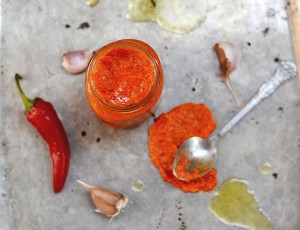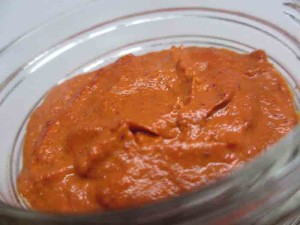Dr. Sarah Cimperman, ND
@DrCimperman
Healthy eating is often associated with boring food, but it doesn’t have to be. Condiments are a simple way to add flavor and flair to any meal, whether you’re eating steamed vegetables and grilled chicken, or an elaborate lamb tagine. Some condiments also have health benefits and harissa belongs at the top of the list. It’s is a paste from North Africa made with antioxidant and anti-inflammatory spices. Harissa can be found in well-stocked grocery stores, but it’s easy and inexpensive to make at home.
Traditionally, harissa is made with chili peppers, garlic, olive oil, and spices which vary from region to region and family to family. The ones I chose for this recipe were selected not only for their flavor, but for the medicinal compounds they contain. Paprika has been shown to have “potent” anti-cancer activity,1 improve HDL cholesterol levels,2 and even play a role in preventing and reversing obesity-related inflammation and insulin resistance.3 Research studies show that cumin4 and turmeric5 can reduce inflammation, lower high blood sugar, aid digestion, inhibit the growth of cancer, and fight disease-causing microbes including methicillin-resistant Staphylococcus aureus (MRSA), Helicobacter pylori, and Candida albicans. Cumin can also modulate the immune system4 while turmeric can ease arthritis, lift depression, and protect the heart, liver, kidneys, and nerves.5 Curcumin, one of the medicinal compounds inside turmeric (not to be confused with cumin, a different spice), is being studied in the prevention and treatment of Alzheimer’s disease.6 Turmeric and curcumin can be difficult to absorb into the bloodstream, but piperine, a compound in black pepper, can increase their availability by 2,000 percent.7 So it’s always a good idea to use turmeric and black pepper together. To help balance some of the heat from the chili peppers, I also added tomato paste, which is a concentrated source of antioxidants like lycopene, shown to protect against cardiovascular disease and cancer.8
In Morocco, harissa is traditionally served with stews and tagines. In climates with four seasons, these hot and heavy dishes are usually regarded as winter food, but in Northern Africa they are served throughout the year and during the hottest weather. It may seem counterintuitive, but chili peppers actually help cool the body by making you sweat. In my kitchen, harissa is a staple for every season. It pairs well with meat, vegetables, tofu, and tempeh, either alone as a spicy condiment or whisked into strained whole milk yogurt and served as a milder dipping sauce. Harissa can also be used as a marinade or a spread for sandwiches and burgers. And it can spice up other foods like salad dressings, stir fry, marinara sauce, hummus, and even scrambled eggs.
 Ingredients:
Ingredients:
- 1 ounce dried red chilies
- 1 large red bell pepper
- 2 tablespoons cold-pressed extra virgin olive oil
- 3 cloves garlic
- 1/2 teaspoon sea salt
- 1/4 teaspoon freshly ground black pepper
- 1/2 teaspoon cumin
- 1/2 teaspoon smoked paprika
- 1/4 teaspoon turmeric
- 2 tablespoons tomato paste
- 3 drops of orange flower water (distilled not flavored, optional)
Method:
- Add the chili peppers to a small saucepan along with just enough water to cover them. Bring the mixture to a boil over low heat. Stir and simmer for two minutes. Stir again and turn off the heat. Cover and set aside for 10 minutes or more.
- Blacken the bell pepper over a flame on a gas stove or cut it in half and broil it, cut-side down, until blackened. Place the blackened pepper in a glass or stainless steel bowl, cover it with a plate, and set it aside to steam.

- To a blender (or food processor), add the olive oil, garlic, salt, pepper, cumin, paprika, turmeric, tomato paste, and orange flower water.
- Once the bell pepper is cool enough to handle, use clean hands to slide off the skins and remove the seeds (do not rinse it). Tear the pepper it into pieces and drop them into the blender too.
- Strain the chili peppers, reserving the liquid in case you want to use it to thin out the harissa later. Add the chili peppers to the blender.
- Blend everything into a smooth paste. Taste for seasoning and make any necessary adjustments. To thin it out, add a splash of water or some of the reserved liquid.
- Store the harissa a labeled, airtight container in the fridge.
 Sarah Cimperman, ND is the author of the new book, The Prediabetes Detox: A Whole-Body Program to Balance Your Blood Sugar, Increase Energy, and Reduce Sugar Cravings. She graduated from NCNM in 2002 and has a private practice in New York City. Her expertise has been featured on Fox News and Huffington Post and in Natural Health magazine, Whole Living magazine, and the Well Being Journal, among other publications. Dr. Cimperman also writes two blogs, A Different Kind Of Doctor and The Naturopathic Gourmet.
Sarah Cimperman, ND is the author of the new book, The Prediabetes Detox: A Whole-Body Program to Balance Your Blood Sugar, Increase Energy, and Reduce Sugar Cravings. She graduated from NCNM in 2002 and has a private practice in New York City. Her expertise has been featured on Fox News and Huffington Post and in Natural Health magazine, Whole Living magazine, and the Well Being Journal, among other publications. Dr. Cimperman also writes two blogs, A Different Kind Of Doctor and The Naturopathic Gourmet.
References:
- Maoka T, Mochida K, Kozuka M, Ito Y, Fujiwara Y, et al. Cancer chemopreventive activity of carotenoids in the fruits of red paprika Capsicum annuum L. Cancer Letters. 2001;172(2):103-9. http://www.ncbi.nlm.nih.gov/pubmed/11566483
- Aizawa K and Inakuma T. Dietary capsanthin, the main carotenoid in paprika (Capsicum annuum), alters plasma high-density lipoprotein-cholesterol levels and hepatic gene expression in rats. The British Journal of Nutrition. 102(12):1760-6. http://www.ncbi.nlm.nih.gov/pubmed/19646292
- Hayato Maeda, Shuuichi Saito, Nozomi Nakamura, and Takashi Maoka. Paprika Pigments Attenuate Obesity-Induced Inflammation in 3T3-L1 Adipocytes. ISRN Inflammation. 2013: 763758. http://www.ncbi.nlm.nih.gov/pmc/articles/PMC3767362/
- A review on therapeutic potential of Nigella sativa: A miracle herb. Asian Pacific Journal of Tropical Biomedicine. 2013; 3(5): 337–352. http://www.ncbi.nlm.nih.gov/pmc/articles/PMC3642442/
- Sahdeo Prasad and Bharat B. Aggarwal. Chapter 13: Turmeric, the Golden Spice, from Traditional Medicine to Modern Medicine. Benzie IFF and Wachtel-Galor S (Eds). (2011). Herbal Medicine: Biomolecular and Clinical Aspects. 2nd edition. Boca Raton, Florida: CRC Press. http://www.ncbi.nlm.nih.gov/books/NBK92752/
- Mishra S and Palanivelu K. The effect of curcumin (turmeric) on Alzheimer’s disease: An overview. Annals of Indian Academy of Neurology. 2008; 11(1): 13–19. http://www.ncbi.nlm.nih.gov/pmc/articles/PMC2781139/
- Shoba G, Joy D, Joseph T, Majeed M, Rajendran R, and Srinivas PS. Influence of piperine on the pharmacokinetics of curcumin in animals and human volunteers. Planta Medica. 1998;64(4):353-6. http://www.ncbi.nlm.nih.gov/pubmed/9619120
- Rao AV and Agarwal S. Role of antioxidant lycopene in cancer and heart disease. Journal of the American College of Nutrition. 2000;19(5):563-9. http://www.ncbi.nlm.nih.gov/pubmed/11022869
